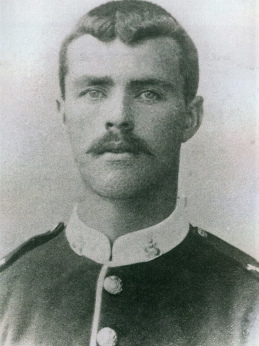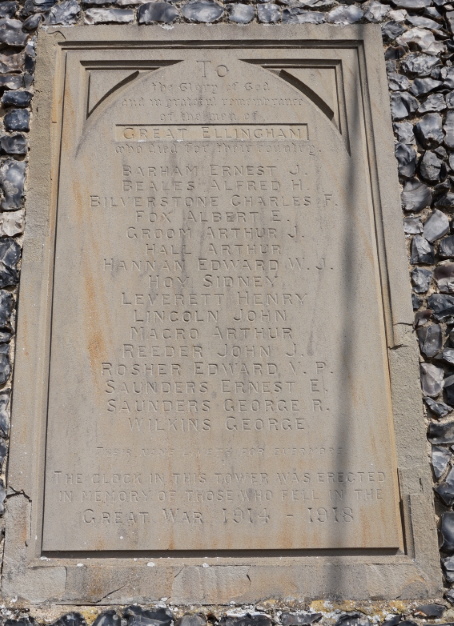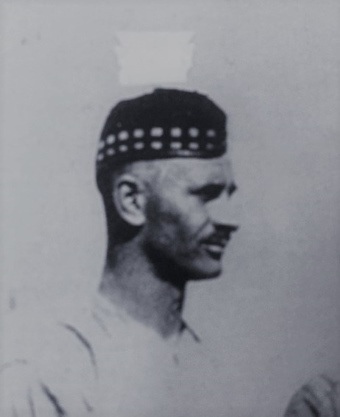John Lincoln (1876-1917) taken whilst serving as a British Soldier during the Boer War. Photograph courtesy of Bryan Dye
‘John Lincoln’ is amongst sixteen names inscribed on the memorial tablet set into the wall near to the west door of St James’s Church. The tablet remembers the Great Ellingham men who gave their lives for their country in the Great War 1914-1918.
Behind the names, are men who once lived in the village just as some of us do today. They too had families, visited the village shops and, perhaps, attended one of the places of worship. As young boys, they may have together played in the streets and, later, enjoyed a drink in one of the pubs with their friends. Some (like John Lincoln), were born in the village and would have also attended one of the village schools.
Death at Vimy Ridge
John Lincoln was 40 years old when, serving as a Lance Corporal with the 15th Battalion of the Canadian Infantry, he died at the Battle of Vimy Ridge in northern France.
Why was John Lincoln with the Canadian Infantry and not a British Regiment?
Early Life
Born on the 2nd December, 1876, John Lincoln was the youngest son (and the seventh of nine children) of John and Elizabeth Lincoln (née Gant). He was baptised in the Church of St James on the 27th May, 1877.
This image of the Long Street/Town Green area would have been familiar to John Lincoln growing up in Great Ellingham
1881 census
The 1881 census captures the Lincoln family living in Town Green. John was very likely born in Town Green.
Aged 42 and born in the village, John Lincoln senior worked as a labourer. His Yorkshire born wife Elizabeth was aged 38. Just three days earlier, Elizabeth had given birth to their daughter, Elizabeth, who was recorded on the census as a 3 day old female infant.
12 year old James was already working as a labourer, and possibly bringing home a much needed additional wage. 10 year old Susannah and 4 year old John were attending school, with two year old Alice at home. 55 year old widow and nurse Harriett Brown completed the household on census night.
1891 census
The 1891 census shows the Lincoln family living in Long Street. However, I suspect the family may well have been living in the same property as they were ten years earlier. In some census returns part of the northern end of Long Street is referred to as Town Green and, in others, as Long Street.
This census reveals 14 year old John with his 50 year old widowed father and sisters, 20 year old Susanna and 10 year old Elizabeth.
John Lincoln senior had buried his wife Elizabeth nine years earlier in the September of 1882. Elizabeth was just 39 years old when she died.
Susanna, described as a housekeeper in the census, had taken over the running of the house for her father and siblings. John and his father were both working as agricultural labourers.
1896 Royal Norfolk Regiment
By 1896, work was becoming scarce for John Lincoln. Accordingly, on the 18th July, 1896, 18 year old John Lincoln joined the Royal Norfolk Regiment.
Four years later, in 1900, John (with the Royal Norfolk Regiment) was posted to South Africa. On the 15th February, 1900, he was involved in the Relief of Kimberley John also served in the Transvaal.
In February, 1903, he returned to Britain with the Regiment. Five months later, on the 16th July, 1903, John was discharged from general army service and transferred to Army Reserve.
Emigration
The following year, on the 16th February, 1904, and at the age of 28, John left Liverpool bound for Canada. He arrived in Canada on-board the SS Lake Erie.
We can but wonder what prompted John to emigrate.
My husband’s great uncle (a Norfolk-born man brought up in Wolverhampton) emigrated to the United States of America at a similar time. He saw new and good opportunities for work, and a chance to ‘better oneself’, by emigrating. He was successful.
Perhaps John Lincoln also saw new and exciting opportunities for a life in Canada?
The early 20th century certainly saw unprecedented levels of emigration from Britain, with the most popular destination being Canada.
Marriage & Children
On the 19th September, 1907, John married Yorkshire born Florence Annie Lee in Toronto. Florence had only arrived in Canada a few months previously.
In 1908, their son, John Albert, was born followed by Stanley in 1909.
The 1911 census captures the family living in Toronto East, Ontario.
John’s father, John Lincoln died in Deopham in the April of 1913. It would have been weeks (if not months) before the news of his father’s death reached John Lincoln in Toronto.
Five months later, John and Florence’s daughter, Ivy, was born on the 6th September, 1913.
The following year, on the 14th August, 1914, Great Britain declared war on Germany.
Canadian Overseas Expeditionary Force
John Lincoln (1876-1917) taken during the Great War. Photograph courtesy of Bryan Dye
On the 28th May, 1915, aged 38, John Lincoln joined the Canadian Overseas Expeditionary Force.
John’s final visit to his home village of Great Ellingham was in 1915 when he stopped off en-route to fight with the Canadian forces in France.
John Lincoln, again taken during World War I. Photograph courtesy of Bryan Dye
Tragically just two years later, he died on the 15th August, 1917 at Vimy Ridge, northern France.
Sources:
Great Ellingham Parish Registers Norfolk Record Office PD 609. Also available at www.familysearch.org
1881 census RG11/1974/80
1891 census RG12/1549/78
Commonwealth War Graves website accessed 15th March 2021
Edinburgh Centre for Global History website. ‘Strangers in a Land of Promise: English Emigration to Canada 1900-1914. Accessed 15th March 2021
Thanks to Bryan Dye, great nephew of John Lincoln 1876-1917




